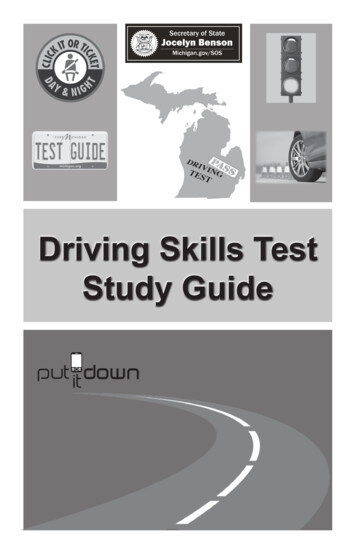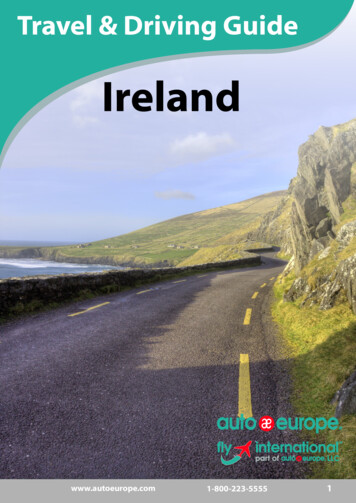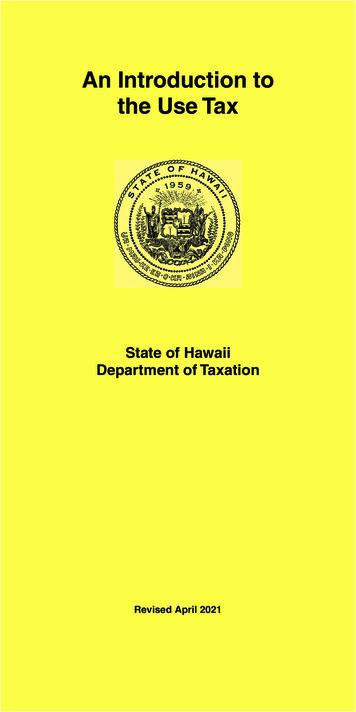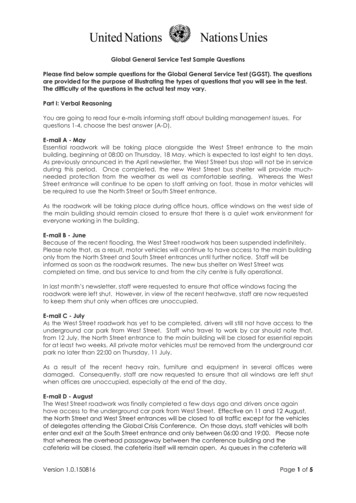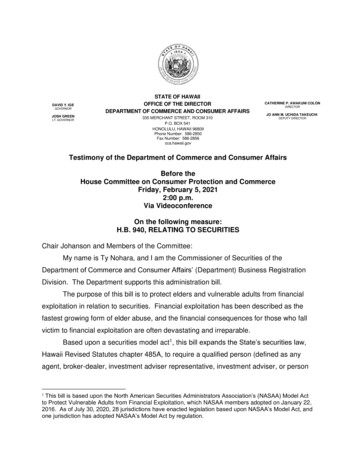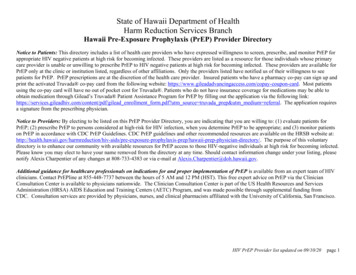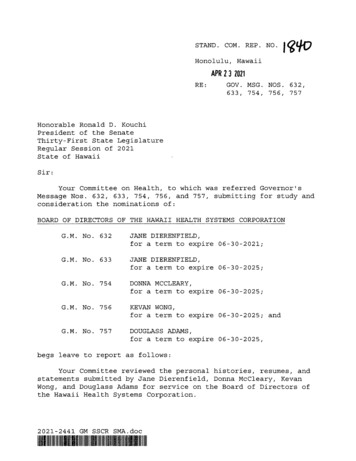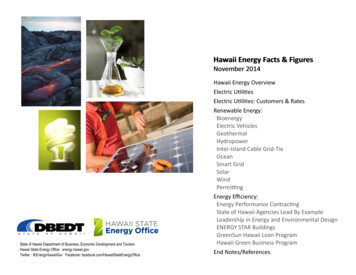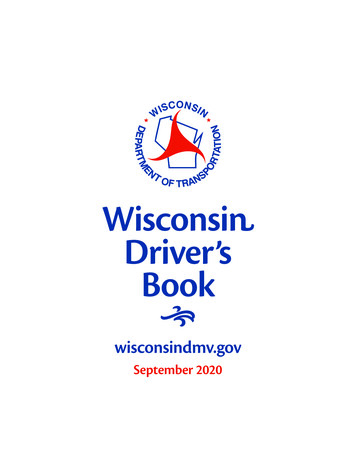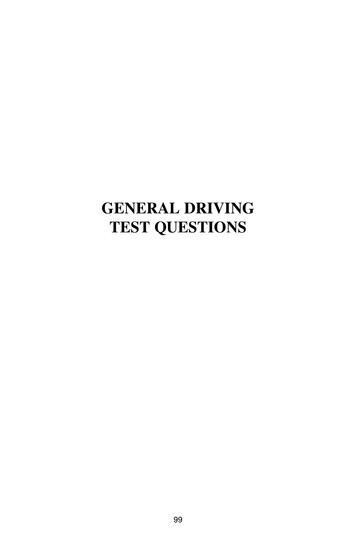
Transcription
GENERAL DRIVINGTEST QUESTIONS99
GENERAL TEST QUESTIONSRef. Pg.151. When you take a road test for a driver’s license:1. You must provide the vehicle.2. The vehicle must be in safe operating condition free of safety defects.3. You must be accompanied to the testing station by a licenseddriver.4. All of the above.162. When you change your address you must notify the CountyExaminer of drivers:1. In writing, within 30 days.2. In writing, within 10 days.3. In person, within 10 days.4. By telephone, within 30 days.163. When you change your name you must notify the CountyExaminer of drivers in person with proof of the change within:1. 60 days.2. 20 days.3. 10 days.4. 30 days.174. When driving a vehicle upon any public street or highway you must:1. Show your driver’s license upon demand.2. Carry your license with you.3. Have a valid driver’s license.4. All of the above.155. When your driver’s license expires you may:1. Drive during the grace period of 90 days.2. Drive as long as you are accompanied by a licensed driver.3. You may not drive but you may renew your driver’s licensewithin a year after the expiration following normal licenserenewal steps.4. Drive to and from work only.20186. All head lamps on your vehicle must work properly and be correctly adjusted:1. When driving in city traffic.2. At all times.3. When driving on freeways.4. When approaching other vehicles.7. Which of the following equipment may you have installed onyour private vehicle?1. A red light showing the front, or a blue light visible outsideof the vehicle.2. A bell, exhaust whistle or siren.3. A muffler cut-out or by pass if used only on country roads.4. None of the above.100
Ref. Pg.198. A copy of the vehicle inspection certificate:1. Should be kept in the vehicle.2. Filed with your State income tax return.3. Be kept in a safe place in the home4. Will be sent to you by the County Department of Finance.199. The mechanical condition of the vehicle is the responsibility of:1. The legal owner of the vehicle.2. The garage mechanic.3. The vehicle driver and registered owner of the vehicle.4. The insurance company.2010. A leaky exhaust system in your vehicle is dangerous because itcan cause:1. A loss of hearing.2. Pollution.3. Carbon monoxide poisoning.4. Poor engine performance.2111. The agencies responsible for Vehicle Registration and Licensingare:1. The County Police Departments.2. The County Departments of Public Works.3. The State Department of Transportation.4. The different county agencies.2112. When you as a registered owner of a vehicle change youraddress from that shown on the registration certificate you:1. Must notify the County Department of Finance when renewing the license.2. Must notify the County Department of Finance within 30days after the change.3. Must make the change only when selling or trading the car.4. Do not have to do anything.2413. The most important thing in any driving situation is:1. The vehicle.2. The environment (the highway and traffic).3. The driver (you).4. The time of day.2414. The boss chews you out just before quitting time. You don’t saymuch, but you think he is unfair and you are angry! When youget to your car you should:1. Play the radio loud so you won’t think about it.2. Drive fast on the Interstate so you can let off steam.3. Take a few minutes to cool off before you drive home.4. Stop in at your favorite bar and have a few drinks beforedriving home.101
Ref. Pg.2515. As a driver, you may be challenged by other drivers to demonstrate your driving capabilities and your vehicle’s capabilities onthe highway. You should:1. Resist the desire to exhibit and compete.2. Decline all challenges to prove you or your vehicle’s capabilities.3. Take on only those challenges which you know you can safelywin.4. Both 1 and 2 above.2516. To insure that your physical condition does not cause you todrive in an unsafe manner you should:1. Keep physically fit and have regular physical examinations.2. Know the effect of any medicine on your driving ability.3. Drive within your physical limitations.4. All of the above.2617. A police officer directing traffic directs you to go through a redlight, what should you do?1. Stop, and then go.3. Go on as directed.2. Wait for the green light.4. Make a right turn.2418. Which of the following influences your driving actions most?1. Your height.3. Your attitude towards driving.2. Your age.4. Your reaction time.2619. Traffic signs and pavement markings must be:1. Always obeyed.2. Used as a guide only.3. Followed only when there is other traffic.4. Followed only when a police officer is present.2620. You are driving on a narrow road and you meet an oncomingvehicle. You must:1. Pull completely off the road and stop.2. Allow the on-coming vehicle at least one-half of the maintravelled portion of the road.3. Make the other vehicle pull over as you were there first.4. Turn on your headlights to make sure the other vehicle sees you.2621. You are passing a car when you see the sign on the picture. Youshould:1. Speed up and finish passing as soon as you can.2. Pass on the right.3. Drop back and pass after the intersection if it’s safe.4. Stay beside the car until passing the intersection.102
Ref. Pg.2922. You are following the slow moving vehicle in the picture on atwo lane road. You may:1. Not pass the vehicle.2. Pass on the left if no traffic is coming.3. Pass on the right using the paved shoulder.4. None of the above.6823. You are driving on a street marked for one-way traffic. You maypass the vehicle in the picture:1. On the left only.2. On the right only.3. On either the right or the left.4. You must always use the lane furthest to the left to pass.2724. When turning or changing lanes you must:1. Always signal your intentions even when there is no trafficvisible.2. Signal only if there is traffic.3. Signal only when driving at night.4. Signal only when driving in traffic at night.2725. You are coming to a railroad crossing and the crossing signalsare flashing. You should:1. Stop and look for a train.2. Slow down and look for a train.3. Look for a train, then speed up.4. Do what the approaching vehicle does.2826. You must not drive your vehicle at a speed greater than:1. The posted maximum speed limit.2. A speed that is greater than is reasonable and prudent.3. A speed that is safe for existing conditions.4. All of the above.2927. When you leave your vehicle unattended, you must:1. Stop the engine.2. Lock the ignition and remove the ignition key.3. Set the parking brake.4. All of the above.2928. You are driving on the roadway and hear a siren behind you. Youshould:1. Stop.2. Pull over to the right and stop.3. Speed up to get out of the way.4. Slow down.103
Ref. Pg.2930&3129. You are driving on the roadway and there is an emergency vehicle with siren and flashing lights directly behind you. You are inheavy traffic and cannot get out of the way. You should:1. Stop.2. Blow your horn.3. Force your way into traffic in the adjoining lane.4. Keep moving slowly until you can get out of the way.30. You may pass another vehicle:1. On a curve or a hill because the chance is small that anothervehicle is coming.2. On the shoulder of the highway.3. When there is a solid yellow line in your lane if it’s clearahead.4. None of the above.3131. You may pass a school bus from the front or rear on an undivided roadway:1. Never.2. When the red lamps on the school bus are flashing.3. When the red lamps on the school bus are not flashing.4. At anytime, if you go slow.3232. An intersection has no traffic signs or signals. You arrive at thesame time as another vehicle. You should:1. Speed up and get through the intersection.2. Slow down and yield to the vehicle on the right.3. Drive into the intersection and make the other vehicle stop.4. Honk your horn and drive through the intersection.3233. You are coming to this intersection. You should:1. Stop.2. Slow down, stop if necessary and let all othercrossing vehicles go first.3. Speed up to clear the intersection.4. Keep going as the sign is for the other vehicle.3234. You are coming to this intersection. You should:1. Slow down and look for other vehicles.2. Come to a complete stop and let all crossing traffic go.3. Stop only if there are other vehicles coming.4. Stop only if you are going to make a left turn.104
Ref. Pg.32&41323232442935. You are coming to an intersection and have a green light.Pedestrians are crossing against the red. You should:1. Honk your horn.2. Speed up and pass in front of the pedestrians.3. Stop to let the pedestrians cross safely.4. Drive close and frighten the pedestrians so they’ll think twicebefore crossing against a red light.36. When you drive into the street from any driveway you:1. Must drive slowly so approaching vehicles and pedestrianscan get out of your way.2. Must honk the horn so approaching vehicles and pedestrianscan allow you room.3. Must stop and proceed only when there are no pedestrians orvehicles approaching.4. Can disregard pedestrians if there is no sidewalk.37. You and another vehicle are approaching an intersection that hasno traffic signs or signals. Which vehicle has the right of way?1. The vehicle on the left.2. The vehicle on the right.3. The vehicle with the greatest speed.4. The vehicle that enters the intersection first.38. When turning left at an intersection or into any driveway you:1. Should leave room on the right for other vehicles to pass.2. Must yield to vehicles approaching closely from the oppositedirection.3. Must not cross any solid yellow line.4. Must not block vehicles approaching from the rear.39. You are stopped behind other vehicles waiting at a stop sign.When the intersection is clear:1. You may proceed through the intersection without stoppingagain.2. You must stop again at the stop sign or stop line.3. You may go through the intersection slowly without stoppingif there is no other traffic.4. You may follow the vehicle ahead without stopping again.40. You are driving on a divided multi-lane highway when you seeor hear the signal of an approaching emergency vehicle. Youshould:1. Disregard the signal if there are other lanes available for theemergency vehicle.2. Stop as quickly as you can.3. Slow down, move your vehicle to provide a clear path for theemergency vehicle and stop.4. Increase your speed to provide a clear path for the emergencyvehicle.105
Ref. Pg.2941. A vehicle using emergency signals is approaching from theopposite direction on a two-lane street or highway. You should:1. Stop as quickly as you can.2. Slow down, move as far to the right as possible and stop.3. Disregard the emergency vehicle as it is going the other way.4. None of the above.2942. On a two-lane street your vehicle is being followed by a fireengine that is not using emergency signals. You should:1. Continue to drive in a normal manner.2. Stop as quickly as you can.3. Speed up to get out of the way.4. Slow down, move as far to the right as possible and stop.3343. Certain highway signs and markings require that you must obeythe indicated instruction. Such signs are known as:1. Regulatory signs.3. Information signs.2. Warning signs.4. Guide signs.3344. Certain highway signs and markings contain information abouthazardous conditions. Such signs are known as:1. Regulatory signs.3. Information signs.2. Warning signs.4. Guide signs.3345. You are turning onto a two-lane road divided by a broken yellowline. You know immediately that:1. You are on a two-way road. 2. You are on a one-way road.3. That the road is under repair.4. That you must stay to the left of the broken yellow lines.3346. You are driving on a highway divided by two solid yellow lines.You know that:1. You may cross these lines only to make a left turn into orfrom an alley, private road or a driveway.2. You may cross these lines to pass other vehicles only if thereis no on-coming traffic.3. You may never cross these lines.4. You may cross these lines only to make a U-turn.2647. You are driving and have started to pass the other car. Youshould:1. Speed up and pass as soon as possible.2. Slam on your brakes.3. Slow down and move into the right lane behind the other car.4. Stay in the left lane until passing the intersection.&33106
Ref. Pg.3448. You are driving on a four-lane divided highway. You shouldknow that:1. White lane lines separate lanes of traffic moving in the samedirection.2. White lane lines separate lanes of traffic moving in the opposite direction.3. Yellow lane lines separate lanes of traffic moving in the samedirection.4. None of the above.3449. You are driving on a four-lane divided highway. The traffic lanesare indicated by a solid white line. You should know that:1. The solid white line may not be crossed.2. The solid white line may be crossed at any time.3. The solid white line may be crossed only in unusual circumstances and then only with great care.4. The solid white line separates traffic moving in oppositedirections.3550. You are driving on a four-lane highway. You should know that adouble solid white line:1. May not be crossed.2. May be crossed only with great care.3. Is used to separate traffic moving in the opposite direction.4. Are never used on highways.3551. Edgelines are solidorlines along the edges of theroadway to be used as a safety guide to mark the limits of thetravelled roadway.1. Yellow; white.3. Orange; white.2. Red; white.4. Green; white.107
Ref. Pg.3652. Stop lines are solid white lines painted across the traffic lanesatandindicating the exact place at which to stop.1. Curves; hills. 2. Churches; schools.3. Intersections; pedestrian crosswalks.4. Freeway on ramps; fire stations.3653. Crosswalk lines are two solid white lines painted across the traffic lanes. As a driver you should know that:1. Motor vehicles have the right of way over pedestrians inthese crosswalks.2. When pedestrians are in these crosswalks, they have the rightof way over motor vehicles.3. No one has the right of way in a crosswalk.4. Pedestrians are responsible to keep out of the way of all traffic.3654. You are driving on a multi-lane roadway. The center lane isformed by a combination of yellow solid and dashed lines asshown in the picture. You as a driver should know:1. That this marked lane is used for passing only.2. That this marked lane is used only for left turns by traffictravelling in either direction.3. That this marked lane is a pedestrian safety zone.4. That this marked lane is used for truck and bus traffic only.3755. Obstruction markings are solid white or yellow lines painted inthe traffic lanes to guide you around obstructions in the road. Asa driver you should know:1. You may pass to either side of white obstruction markings.2. You may pass to either side of yellow obstruction markings.3. Both 1 and 2 above.4. None of the above.3756. The painted markings in the picture mean that:1. Vehicles from both lanes can go straight or turn right.2. Vehicles in the left lane must go straight, and vehicles in theright lane can go straight or turn right.3. The signs are just advisory.4. Vehicles in the left lane may go straight or turn left and vehicles in the right lane must turn right.108
Ref. Pg.3957. A red traffic signal light means that you must:1. Stop at the stop line.2. When there is no stop line, stop before entering any crosswalk.3. Where there is no stop line or crosswalk, stop before entering the intersection.4. All of the above.3958. A stopped vehicle facing a circular red traffic light may if notprohibited by a traffic sign:1. Turn right after yielding to other traffic and pedestrians.2. It is illegal to turn right on red.3. Turn right at any time.4. Turn right only after blowing the horn.3959. A stopped vehicle facing a circular red traffic light may turn leftif not prohibited by a traffic sign:1. When there is no other traffic or pedestrians.2. Never.3. Only right turns on red are permitted in Hawaii.4. After yielding to pedestrians and traffic, when turning from aone-way street into another one-way street.3960. A steady circular yellow light on a traffic signal means:1. You should speed up to beat the red light.2. That a red light is going to be shown immediately thereafter.3. You should avoid entering the intersection if possible.4. Both 2 and 3 above.4061. A circular green traffic light means:1. That you always have the right of way.2. That you may go straight ahead or turn, except where signsprohibit turns.3. Traffic and pedestrians already in the intersection must getout of your way.4. Both 2 and 3 above.4062. Lighted arrows are sometimes used to control turns from a specific lane. A red arrow:1. Is never used as a traffic signal.2. Means the same as a circular red light for the indicated laneof traffic.3. Means that you may go in the direction indicated by thearrow.4. Means that the traffic the arrow is pointing toward must stop.109
Ref. Pg.4063. Lighted arrows are sometimes used to control turns from a specific traffic lane. A yellow arrow:1. Is never used as a traffic signal.2. Means the same as a circular yellow light for the indicatedlane of traffic.3. Means that you may go in the direction indicated by thearrow.4. Is warning the traffic a green arrow is about to be shown.4064. Lighted arrows are sometimes used to control turns from a specific traffic lane. A green arrow:1. Is used only on one-way streets.2. Means the same as a circular green light, but you must goonly in the direction the arrow indicates.3. Means that you may go only if the green arrow is accompanied by a green light.4. Points the way to the airport.4165. A red flashing signal means the same as a:1. Red light.3. Yield sign.2. Stop sign.4. Caution sign.4166. You are approaching a flashing red signal at this intersection.You should:1. Come to a complete stop. Check the traffic and go when it issafe.2. Slow down and yield the right of way.3. Stop only if turning left.4. Be prepared to stop.4167. The yellow flashing signal in the picture means:1. That the roadway ends.2. That you must stop.3. That you may proceed only with caution.4. That you must stop for cross traffic.4168. A lighted red “X” over a traffic lane means:1. That you may use that lane.2. That you may not use that lane.3. That the lane is for traffic coming toward you.4. Both 2 and 3 above.110
Ref. Pg.4069. A lighted green arrow over the traffic lane means:1. That you may use that lane.2. That you may not use that lane.3. That the lane is for traffic coming toward you.4. Both 2 and 3 above.4270. A yellow “X” over the traffic lane means:1. That you must move out of that lane of traffic because it isgoing to be used for on-coming traffic.2. That you may use that lane.3. That the lane is for left turns only.4. That you may use the lane but with caution.4271. Pedestrian signals consist of the lighted words “WALK” and“DON’T WALK” and the symbols of a walking person and anupraised palm. A steady “DON’T WALK” or upraised palm signal means:1. Pedestrians must not enter the roadway toward the signal.2. Pedestrians already in the intersection facing the signal maycontinue to the nearest sidewalk, traffic island or safety zone.3. Pedestrians already in the intersection facing the signal mustrun to the nearest sidewalk.4. Both 1 and 2 above.4572. This is a “reduced speed ahead” sign. You as a driver should know:1. That you should maintain your vehicle’s speed till youget to the slower speed zone.2. That you should begin to reduce your vehicle’s speed.3. That it’s dangerous to slow down because traffic startsto back up.4. That the sign is only there for poke-along drivers.4573. While driving you come upon a sign which says, “reduced speed35 MPH”. You as a driver should know:1. That the new 35 MPH speed zone begins at this sign.2. That the new 35 MPH speed zone begins at the next “speedlimit” sign.3. That you have plenty of time to slow down before the speedzone.4. That the sign is put there to harass “good” drivers.4574. This is a “do not pass” sign. You as a driver should know:1. That you must not pass another vehicle where thesesigns are posted.2. That you may pass a slow moving vehicle here if youcan pass quickly.3. That it’s all right to pass here if you “know the roadahead.”4. That it’s all right to pass here at night when the headlights of on-coming traffic can be seen.111
Ref. Pg.4675. This sign means:1. No U turn.2. U turn permitted.3. Winding road.4. Sharp left turn.4676. This sign means:1. No right turn.2. Right turn permitted.3. Stop before turning right.4. Sharp curve ahead.4677. This sign means:1. Stop.2. Do not enter.3. Railroad crossing.4. Yield.4878. This sign means:1. Lane signal.2. Lane closed for traffic.3. Railroad crossing ahead.4. Traffic signal ahead.4779. This sign means:1. One-way traffic.2. Divided highway ahead.3. Two-way traffic.4. Keep left.4780. This sign means:1. One-way traffic.2. Divided highway ends.3. Two-way traffic.4. Keep right.4781. This sign means:1. Trucks only.2. Trucks entering highway.3. Hill.4. Trucks have the right of way.4782. This sign means:1. Slippery when wet.2. Watch for drunk drivers.3. Dangerous curve.4. Bump in road ahead.4783. This sign means:1. School.2. School crossing.3. Pedestrian crossing.4. Workmen in road.112
Ref. Pg.4784. This sign means:1. Narrow bridge.2. Lane ends or roadway narrows.3. Industrial area.4. Freeway on ramp.4885. This sign means:1. School.2. School crossing.3. Pedestrian crossing.4. Children in road.4886. This sign means:1. School.2. School crossing.3. Pedestrian crossing.4. Children in road.5587. Persons driving under the influence of intoxicating liquor are:1. Every driver’s problem whether they drink or not.2. Only a problem to those who drink.3. Not a problem in Hawaii.4. A police enforcement problem only.5588. A few drinks after work before driving home:1. Is good because you miss the rush traffic.2. Is good because they help to release the day’s tension andmake you a safer driver.3. Should be avoided because they may make you a dangerousdriver.4. Never hurt anyone.5589. Alcoholic beverages will affect you:1. More rapidly just after eating.2. More rapidly on an empty stomach.3. The same way at all times.4. Only if you have more than two drinks.5590. After the alcohol has entered your blood you can lessen its effect by:1. Taking a cold shower.2. Drinking black coffee.3. Both 1 and 2 above.4. There is nothing you can do to lessen the effect.5691. A police officer stops you, charges you with driving under theinfluence of alcohol, and tells you, you must take a test to determine the amount of alcohol in your blood. You as the driver:1. Don’t have to take the test if you can prove you weren’tdrinking.2. Must take the test or risk losing your driver’s license.3. Don’t have to take the test if you have not violated any traffic rule.4. Don’t have to do anything.113
Ref. Pg.5692. You have been charged with driving under the influence of alcohol, and have refused to take the required test for blood alcohol.You may lose your driver’s license for twelve months:1. Only if you are convicted of driving while under the influence of alcohol.2. Only if you are convicted of a traffic violation.3. Because you have refused to take the test.4. You won’t lose your license.5693. You may drink alcoholic beverages in a vehicle on a public highway:1. As long as you don’t drive.2. Only if you ride in the back seat.3. Only if you ride in the back of a pick-up truck.4. It is against the law to drink alcoholic beverages on a publichighway.5694. Drugs may interfere with a person’s ability to drive safely:1. Only if the drugs are prescribed by a doctor.2. Only when taken while drinking.3. Only when driving at night.4. And it is important to ask your doctor about any effects thatthe prescribed drugs may have on your driving ability.5695. The consumption of alcohol while taking drugs can:1. Have a less pronounced effect than either taken separatelyand is always safe.2. Have a more pronounced effect than either taken separately.3. Help cure your illness.4. Improve your driving ability.5596. The effect that alcohol has on your reflexes and judgment:1. Is less if you were only drinking beer.2. Is less if you were only drinking wine.3. Is greater if you were drinking whiskey or hard liquor.4. Depends on the amount of alcohol in your blood stream.5797. When you are driving a vehicle the act of turning your head andlooking before changing lanes, driving away from a curb or exiting your vehicle into traffic is:1. A bad driving habit.2. A good driving habit.3. Unnecessary.4. Not necessary if you use the rear-view mirror.5798. When you are driving, failing to turn your head to check for traffic before changing lanes, driving away from a curb or exitingyour vehicle in traffic is:1. All right if you first check the rear-view mirror.2. A bad driving habit.3. Many times the cause of a traffic accident.4. Both 2 and 3 above.114
Ref. Pg.7499. When you are driving, signaling your intentions before turning,changing lanes or driving away from a curb:1. Is necessary only if other traffic is present.2. Is a good driving habit, and is required by law.3. Is necessary only during the maneuver, not before.4. Is not necessary if the maneuver is done slowly.67100. You are driving on a four-lane divided highway, two vehicles aredriving side by side ahead of you, and you are in a hurry. Youshould:1. Drive closely behind the vehicle in the left lane and flashyour headlights.2. Drive closely behind the vehicle in the right lane.3. Drive in either lane with at least a two-second time intervalbehind the vehicle ahead.4. Drive closely behind the vehicles ahead changing lanes frequently.39101. You are coming to this intersection, and are planning on turningright. There is a vehicle close behind you. You should:1. Signal, slow down, turn right.2. Signal, come to a complete stop, and turn right when theintersection is clear of pedestrians and vehicles.3. Signal, come to a complete stop, wait for a green light, turnright.4. Slow down, turn right.&5767102. When driving in heavy traffic you should:1. Drive close to the vehicle ahead to keep other vehicles fromcutting in.2. Drive close to the vehicle ahead being ready for a suddenstop.3. Both 1 and 2 above.4. Keep at least a two-second interval behind the vehicle ahead.57103. You are driving behind another vehicle. You notice that the driveris driving with one hand, talking to a passenger. You as a driver:1. Know that you should give the vehicle ahead extra room.2. Know that the driver in the vehicle ahead is reducing hissafety margin by being an inattentive driver.3. Know that you should avoid this bad habit.4. All of the above.&58115
Ref. Pg.57104. An inattentive driver is a driver who:1. Daydreams or gazes at objects off the roadway while driving.2. Carries on an eye-contact conversation with a passengerwhile driving.3. Restricts his attention to only watching the vehicle ahead.4. All of the above.58105. An arrogant driver is a driver who:1. Is purposely in a hurry, competing with other traffic.2. Shows little or no respect for traffic laws, or the right-of-wayof others.3. You should try to avoid when driving.4. All of the above.59106. Defensive driving is a driving technique in which you as a driver:1. Identify dangerous driving situations and take action to avoidan accident.2. Defend against poor drivers by getting ahead of them in traffic.3. Defend yourself against accidents by following close to thevehicle ahead.4. Defend against accidents by driving your vehicle fast enoughto stay ahead of traffic congestion.59107. To practice defensive driving you should:1. Be aware of developing traffic situations around you.2. Look well ahead of your vehicle and maintain a proper following distance.3. Have an alternate plan of action ready. (Always leave yourself a way out)4. All of the above.59108. Information you need to drive safely is gained primarily by:1. Seeing.2. Talking to yourself.3. Following other traffic.4. Turning the radio.59109. Increasing your vehicle’s speed:1. Increases your field of vision.2. Decreases your field of vision.3. Makes it easier to see cross traffic.4. Has no effect on your field of vision.60110. Your physical and mental condition as a driver:1. Are not important.2. Are very important safety factors when driving.3. Have no effect on your driving ability.4. Both 1 and 3 above.&58116
Ref. Pg.60111. You notice a vehicle defect which may affect the safe operationof your vehicle. You should:1. Correct the defect as soon as possible.2. Correct the defect when you can afford it.3. Drive the vehicle slower.4. Not carry passengers until the defect is corrected.60112. You borrow your friend’s vehicle. You have never driven it before.You should:1. Drive away, all vehicles are similar.2. Don’t show your friend that you are unfamiliar with his vehicle.3. Disregard any obvious defects so as not to embarrass yourfriend.4. Take a few minutes to familiarize yourself with the operationand location of all the vehicle’s equipment.60113. When driving to an unfamiliar area you:1. Can depend on road signs to find your way.2. Should plan your trip.3. Only have to know generally where your destination is.4. Should always choose the most direct route.60114. Newer vehicles have equipment warning lamps installed on thevehicle’s instrument panel. Which of the following statements iscorrect?1. Before the engine is started the lamps should all be illuminated when the ignition switch is first turned on.2. No lamps should illuminate until the engine is running.3. The lamps should never illuminate unless there is a malfunction.4. The lamps will only illuminate if the head lamps are turned on.61115. Newer vehicles are equipped with a brake warning lamp. Thislamp:1. Should come on when the parking brake is released.2. Should not come on when the foot brake pedal is pressed.3. Should never come on.4. Indicates that the brake lights are operational.61116. Safety belts are life belts. T
3. Drive into the intersection and make the other vehicle stop. 4. Honk your horn and drive through the intersection. 33. You are coming to this intersection. You should: 1. Stop. 2. Slow down, stop if necessary and let all other crossing vehicles go first. 3. Speed up to clear the intersection. 4. Keep going as the sign is for the other .
